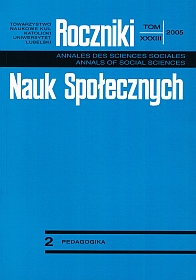Ignacy Wachowiak – tancerz, choreograf, pedagog (1936-1996)
Abstrakt
Ignacy Wachowiak (1936-1996) was a prominent Lublin dancer and choreographer. In the period of 1980-1996 he was a director of the Song and Dance Company of the Lublin Region.
His attitude, personality, and choice of the way of life were decisively affected by Wanda Kaniorowa. In 1948 she took Ignacy to her Theatre of the Young Spectators, five years later transformed into a folklore group. W. Kaniorowa developed the skills of her pupils, shared with them her pedagogical knowledge and abilities in dancing, choreography, directing, and managing. In effect, I. Wachowiak came to love folklore, learned it and popularised throughout his life.
In the period of 1953-1964 I. Wachowiak performed in ZPiTZL as a soloist – dancer. While he was in the army (1956-1958), he danced in the Central Artistic Company of the Polish Army. Endowed with talents and temperament, he learned the technique and rendered the character of the most demanding dances. He was not spoilt as a member of the company. At the age of 24 he was threatened with a disability due to a contusion while dancing. His effective action at the right moment several times saved the ensemble from dissolution. He put high aspirations into practice by a well-directed daily work.
- Wachowiak put the Company first before material values. In 1964 he obtained a full-time job there as an instructor and choreographer. Having graduated from the Pedagogical Institute for Dance of the Central Amateur Counselling of the Artistic Movement, in the specialities of folk and ballroom dance, even obtaining the highest “S” category in choreography, he continued education without interruption.
From 1965 onwards he became well-known as a choreographer of dance suites. In his work he carried out two goals: artistic and formative, and both of them he treated as equally important. He passed his skills on the members – amateurs - of the Ensemble. He was disciplined, conscientious, ambitious, and gathered people of the same kind around himself. All the positions of the repertoire prepared under his direction were characterised by a striving after perfection: clarity of the drawing, faithfulness to the climate and character, and the style of music. Their performers distinguished themselves in dancing. He was successful on the stages of Poland and the world, trying to get higher and higher – according to the will of W. Kaniorowa.
Faithful to folklore, he would extend his interest onto the world heritage of folk culture. In 1985 he established one of the most joyful artistic events in Poland: International Folklore Encounters.
- Wachowiak was thought to be a choreographer with a charisma. He was especially predisposed to work at large outdoor performances and supervise thousands of participants. From 1984 onwards he was entrusted with the organisation of the harvest festival. In 1988 as the first one in post-war Poland he introduced some patriotic elements to commemorate the 70th Anniversary of Independence into the curriculum of the feast of harvest in Marszewo.
Wachowiak believed it was his success to in the ensemble the values advocated by W. Kaniorowa: a family “sunny” atmosphere, the ties among the members of the Company, and the joy of dancing in all dancers. In his message he left for the followers I. Wachowiak expressed his wish to cultivate the transcendent values: beauty and goodness. He prepared choreographers for the Ensemble that would continue his work. One year and a half after his death the Representation of the Lublin Song and Dance Company conducted by Bożena
Baranowska gained the highest score and Grand Prix at a tournament of continents in Brasil. The band was conducted by Włodzimierz Kukawski and the whole was directed by Alicja Lejcyk-Kamińska.
A question arises: what was so strong to have bound the various generations of artists and dancers with the Lublin ensemble? The author puts forward a hypothesis that the solid emotional relationship with the work in the Company consisted of four elements mentioned by humanistic ergonomic. Successive directors and instructors distinguished themselves by thorough professionalism in their disciplines. One of the components of artistic activity is thinking – conceptual, creative work. The member of the Company acquired skills and travelled, thereby satisfying their aesthetic needs and participating in fun. In their work on behalf of the common good and in social work there was sacrifice as well. The large number of the levels of the Company's activity provides topics for research on its history and today.
Copyright (c) 2005 Roczniki Nauk Społecznych

Utwór dostępny jest na licencji Creative Commons Uznanie autorstwa – Użycie niekomercyjne – Bez utworów zależnych 4.0 Międzynarodowe.


